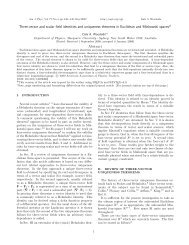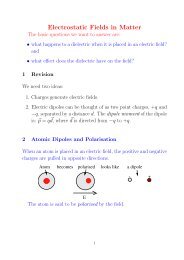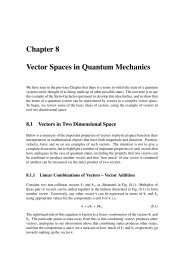AOS News - The Australian Optical Society - Macquarie University
AOS News - The Australian Optical Society - Macquarie University
AOS News - The Australian Optical Society - Macquarie University
- No tags were found...
Create successful ePaper yourself
Turn your PDF publications into a flip-book with our unique Google optimized e-Paper software.
<strong>AOS</strong> <strong>News</strong> Volume 25 Number 1 2011following March, Dr Martin Platt ofCSIRO Division of MeteorologicalPhysics brought a radiometer to Adelaideto measure radiance of clouds, as afunction of height as determined bylidar observations. In mid 1970 Bartusekand Gambling submitted their PhDtheses, and Gambling returned to WRE.Meanwhile Bartusek continued operationof lidar until late 1970, to complementPlatt’s radiometric studies of cirrus cloudsover Adelaide. In 1971 David McGrathused the lidar for his BSc Honours project, in which he made studies of troposphericaerosols.Stuart Young enrolled in February1973 in a PhD program entitled “Lidarstudies of atmospheric aerosols”. Overthe next year he rebuilt the lidar andthen proceeded to make measurements ofstratospheric aerosol profiles over severalyears, which culminated in a 1979 paperin Nature. Following this the lidar projectwas closed down in 1980. Leon Thomaswas a gifted technician who had workedfor many years on the lidar project.When the lidar work ceased he becameresponsible for technical support of thePhysics teaching labs.In the early 1980’s Dr Fred Jacka,the director of the Mawson Institute forAntarctic Research, proposed a lidar systemthat would be capable of measuring windsin the upper atmosphere. This followedFigure 3. <strong>The</strong> 1 m primary receiver mirrorunder construction at the <strong>University</strong> ofAdelaide. It has a substrate of aluminiumalloy. In the background is the polishingmachine.on from techniquesdeveloped to measurewinds and temperaturesusing airglow as a source.Due to the limitedresources and fundingdevelopment was slow.Polishing the one meterprimary mirror of thereceiver in house was a major taskundertaken by Stephen Argall, who wasthe PhD student working on the project.This was to form a steerable telescopewhich would be used for transmit andreceive, and enable line of sight windmeasurements 360° azimuth, within 60°of zenith.A shutter mirror system was used toswitch the telescope between the lasertransmitter and the receiver system toprevent the backscatter from opticalcomponents, and tropospheric aerosols,saturating the receiver. <strong>The</strong>re was alsoprovision for a dual etalon Fabry-Perotspectrometer to be inserted in the receivepath to measure the Doppler shift in thereceived signal and hence the line of sightwind. (This type of lidar is known nowas high spectral resolution lidar, and istypically used to measure temperatureby isolating the Mie scattering from theRayleigh, on account of the differentDoppler broadening of aerosols andmolecules). <strong>The</strong> laser was a copper vapourtype, with 2 kHz pulse rate and averagepower 4 W. <strong>The</strong> initial design of themirror shutter was unsatisfactory and itwas replaced by a system of three shuttersrotating at 24,000 rpm. <strong>The</strong>se were drivenby digital control circuitry that held theirrelative position to within ± 0.1mm.<strong>The</strong> system was used for Rayleighscattering measurements at BucklandPark (about 40 km north of Adelaide)while the Fabry-Perot spectrometer wasstill under construction. Measurementsof backscatter up to 60 km height weremade by Stephen Argall between March1992 and May 1993, and publishedin 1996. From the Rayleigh scatteredFigure 4. <strong>The</strong> lidar telescope at Buckland Park protrudingabove the lidar building.signal, temperature profiles of the middlestratosphere were also extracted.<strong>The</strong> equipment was then transferredto <strong>Australian</strong> Antarctic Division whodid further development (includingreplacement of the Cu vapour laser with afrequency doubled Nd laser), and installedit at Davis base in 2000. <strong>The</strong> Davis lidarhas now been operating more or lesscontinuously since then.<strong>The</strong> author is grateful for the input ofGraham Elford and Don Creighton whoprovided most of the material, and toStuart Young for reviewing the manuscriptand making corrections.ReferencesArgall P.S. & Jacka F. Appl. Optics 35,2619, (1996) “High-pulse-repetitionfrequencylidar system using a singletelescope for transmission and reception”Bartusek, K., Gambling, D. J. andElford, W. G. Journal of Atmosphericand Terrestrial Physics 32, 1535, (1970)“Stratospheric aerosol measurements byoptical radar”Klekociuk, A.R. (1995) An <strong>Australian</strong>atmospheric Lidar for Antarctica.<strong>Australian</strong> <strong>Optical</strong> <strong>Society</strong> <strong>News</strong> 9(3).6-10Platt, C. M. R. J. Atmos Scienc. 30,1191, (1973) “Lidar and RadiometricObservations of Cirrus Clouds”Young, S.A. and Elford, W.G. Nature,278, 541, (1979) “Stratospheric aerosoloptical thickness measurements at 35 o S”Murray Hamilton is with the Schoolof Chemistry and Physics at the<strong>University</strong> of Adelaide.20
















